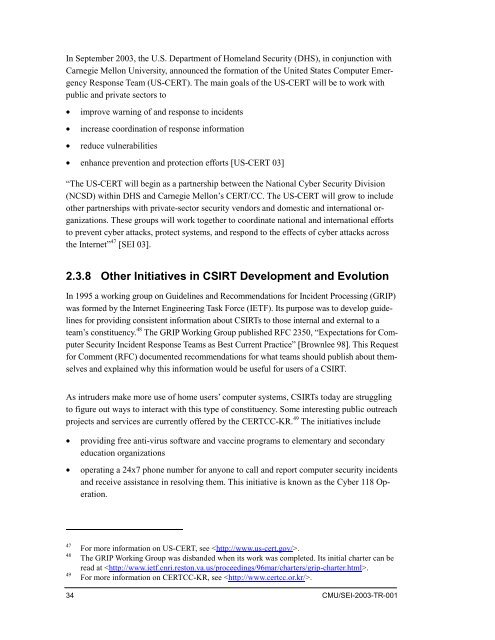State of the Practice of Computer Security Incident Response Teams ...
State of the Practice of Computer Security Incident Response Teams ...
State of the Practice of Computer Security Incident Response Teams ...
Create successful ePaper yourself
Turn your PDF publications into a flip-book with our unique Google optimized e-Paper software.
In September 2003, <strong>the</strong> U.S. Department <strong>of</strong> Homeland <strong>Security</strong> (DHS), in conjunction with<br />
Carnegie Mellon University, announced <strong>the</strong> formation <strong>of</strong> <strong>the</strong> United <strong>State</strong>s <strong>Computer</strong> Emergency<br />
<strong>Response</strong> Team (US-CERT). The main goals <strong>of</strong> <strong>the</strong> US-CERT will be to work with<br />
public and private sectors to<br />
• improve warning <strong>of</strong> and response to incidents<br />
• increase coordination <strong>of</strong> response information<br />
• reduce vulnerabilities<br />
• enhance prevention and protection efforts [US-CERT 03]<br />
“The US-CERT will begin as a partnership between <strong>the</strong> National Cyber <strong>Security</strong> Division<br />
(NCSD) within DHS and Carnegie Mellon’s CERT/CC. The US-CERT will grow to include<br />
o<strong>the</strong>r partnerships with private-sector security vendors and domestic and international organizations.<br />
These groups will work toge<strong>the</strong>r to coordinate national and international efforts<br />
to prevent cyber attacks, protect systems, and respond to <strong>the</strong> effects <strong>of</strong> cyber attacks across<br />
<strong>the</strong> Internet” 47 [SEI 03].<br />
2.3.8 O<strong>the</strong>r Initiatives in CSIRT Development and Evolution<br />
In 1995 a working group on Guidelines and Recommendations for <strong>Incident</strong> Processing (GRIP)<br />
was formed by <strong>the</strong> Internet Engineering Task Force (IETF). Its purpose was to develop guidelines<br />
for providing consistent information about CSIRTs to those internal and external to a<br />
team’s constituency. 48 The GRIP Working Group published RFC 2350, “Expectations for <strong>Computer</strong><br />
<strong>Security</strong> <strong>Incident</strong> <strong>Response</strong> <strong>Teams</strong> as Best Current <strong>Practice</strong>” [Brownlee 98]. This Request<br />
for Comment (RFC) documented recommendations for what teams should publish about <strong>the</strong>mselves<br />
and explained why this information would be useful for users <strong>of</strong> a CSIRT.<br />
As intruders make more use <strong>of</strong> home users’ computer systems, CSIRTs today are struggling<br />
to figure out ways to interact with this type <strong>of</strong> constituency. Some interesting public outreach<br />
projects and services are currently <strong>of</strong>fered by <strong>the</strong> CERTCC-KR. 49 The initiatives include<br />
• providing free anti-virus s<strong>of</strong>tware and vaccine programs to elementary and secondary<br />
education organizations<br />
• operating a 24x7 phone number for anyone to call and report computer security incidents<br />
and receive assistance in resolving <strong>the</strong>m. This initiative is known as <strong>the</strong> Cyber 118 Operation.<br />
47<br />
48<br />
49<br />
For more information on US-CERT, see .<br />
The GRIP Working Group was disbanded when its work was completed. Its initial charter can be<br />
read at .<br />
For more information on CERTCC-KR, see .<br />
34 CMU/SEI-2003-TR-001
















